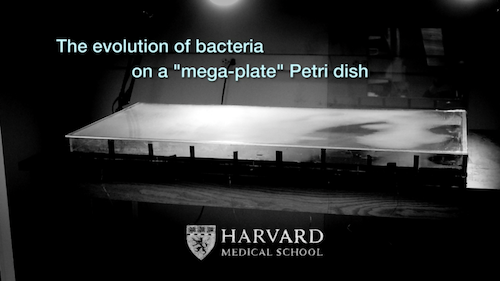 Evolution
Evolution
 Intelligent Design
Intelligent Design
 Medicine
Medicine
Antibiotic-Resistant Bacteria May Be a Health Nightmare, but Not an Evolutionary One

Jerry Coyne’s blog, Why Evolution Is True, has this headline:
Of course by “creationists” he means anyone who doubts the creative power of unguided evolutionary processes. What’s the subject of our nightmare? An experiment, reported in Science, and accompanying videos demonstrating the rapid development of antibiotic-resistant bacteria. That is an old standby in the evolutionist’s arsenal.
Coyne:
Over at the Atlantic, Ed Yong shows and describes some stunning videos of “evolution in action”: in this case bacteria evolving resistance to antibiotics. It’s a clever way to visualize the accumulation of mutations over time as bacteria evolve to survive increasingly large doses of antibiotics. …
The setup for these videos, and the conception of the experiment, was by Michael Baym at Harvard. His team built a huge petri dish, four feet by two feet, filled with agar colored black (to visualize the bacteria). At the edges of the “plate,” as shown below, there was no antibiotic in the agar. Then, as one moved toward the middle, antibiotic concentrations increased in a logarithmic manner, until in the middle there was a thousand times the amount of antibiotic that would kill the bacteria initially (the amount that would kill nearly all of them at first is the “1” stripe in the screenshot below).
Plates were then inoculated with E. coli at the two ends and allowed to adapt to the antibiotic by mutations and natural selection. They could grow toward the center only as resistance mutations accumulated. The bacteria are light colored so you can see the evolutionary wave of advance.
If anything gives us nightmares, it’s not this. Click on the image to go to the video at NPR:

Why? Because no newly evolved complex information has been demonstrated. Here is the Abstract from Science (“Spatiotemporal microbial evolution on antibiotic landscapes“):
A key aspect of bacterial survival is the ability to evolve while migrating across spatially varying environmental challenges. Laboratory experiments, however, often study evolution in well-mixed systems. Here, we introduce an experimental device, the microbial evolution and growth arena (MEGA)-plate, in which bacteria spread and evolved on a large antibiotic landscape (120 × 60 centimeters) that allowed visual observation of mutation and selection in a migrating bacterial front. While resistance increased consistently, multiple coexisting lineages diversified both phenotypically and genotypically. Analyzing mutants at and behind the propagating front, we found that evolution is not always led by the most resistant mutants; highly resistant mutants may be trapped behind more sensitive lineages. The MEGA-plate provides a versatile platform for studying microbial adaption and directly visualizing evolutionary dynamics.
The key to understanding the paper is its Figure 3C. There it shows the genes that have undergone more than one mutation across tested bacteria. They break the mutations down into silent changes, changes of amino acids (point mutations), and insertion-deletion or nonsense mutations, which almost certainly are loss of function (LOF). Over half of genes contain such LOF mutations, along with some point mutations, which likely also degrade or destroy function. In other words, devolution.
Moreover, as the paper in Science points out in its conclusion, “The MEGA-plate is not intended to directly simulate natural or clinical settings,” but “its relative simplicity and ability to visually demonstrate evolution makes the MEGA-plate a useful tool for science education and outreach.” In other words, the MEGA-plate does not correspond to the real world and may be irrelevant to medicine. Instead, its value will be primarily to indoctrinate students in evolution.
Despite its dubious relevance to medicine, the second author, Tami Lieberman (an “evolutionary microbiologist,” not a physician), told NPR: “Getting more people to understand how quickly bacteria evolve antibiotic resistance might help people understand why they shouldn’t be prescribed antibiotics.” Now that’s downright irresponsible, at least as the comment is phrased. As Dr. Lieberman knows, properly used antibiotics save lives.
Image credit: Edvard Munch [Public domain or Public domain], via Wikimedia Commons.
